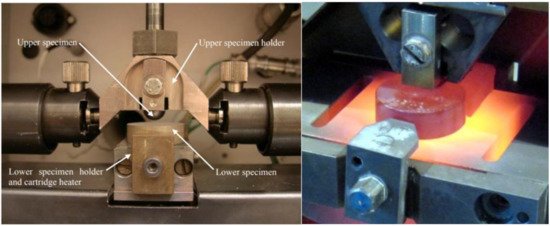High temperature tribology is considered to begin from a minimum temperature of 300–350 °C, where organic base oils and polymers begin to decompose, until a temperature of 1000 °C. In this field of tribology, tests are typically run under dry or solid-state friction, unless a solid lubricant is used, since most lubricants will oxidize or break down when exposed to these extreme temperatures. Therefore, this form of tribotesting is useful to determine the friction, wear, and other tribological characteristics of coatings, ceramics, alloys, cermets, and similar materials.
- high temperature tribotesting
- SRV
- friction
- wear
1. Background
The need to reduce dry wear effects has been around for thousands of years in simple tools and instruments. However, it was not until the industrial revolution that the uses of iron and steel shafts, along with softer bearing materials became more prominent [1]. In a study done by Professor D. Dowson [1], the wear effects of various material combinations were analyzed. The study focused on the friction effects of ceramic coatings, which were neglected in the times when steel and iron bearings were predominant, but have been gathering interest since they are less likely to react when compared to metal materials and their capabilities maintain their functions at elevated temperatures. The study shows that metal on metal combination gives the highest wear factor, k, while the ceramic on ceramic wear gives one of the lowest wear factors. Nevertheless, they are not impervious to wear and the aforementioned scenario only applies at moderate loads and speeds. An increase in the load, oscillation speed, or distance causes a decrease in wear resistance. Furthermore, the debris that result from the friction process can cause further wear damage due to their abrasive nature.
As medical technology advances, certain procedures such as total hip joint replacements (THRs) are made possible. However, the materials of the THRs will start to wear over time and a study by Beadling et al. [2] focuses on the tribological aspects of the metal-on-metal wear and degradation of THRs in order to reduce repeated revisions. In this study, the process of understanding the “tribocorrosive contact” was investigated using simplified 2D models and taking into account simple walking data. A simulator was used with three electrodes to measure the corrosive break down of the materials. The acquired result was that the tribological wear of the metal-on-metal materials greatly correlated with the electrochemical degradation. When the currents are at their highest, the lubricant films are at their thinnest, which leads to a cascade of increased abrasion and thus a higher corrosion. The authors admitted that while this study showed good results, it still has its limits in that more complicated tasks cannot be easily simulated. This work showed how tribology can be used for practical applications in the medical field.
2. Tribometer for High Temperature Applications
This review will focus on the Optimol Schwingung, Reibung, Verschleiž (SRV) tribometer, which is a widely used tribometer that can be modified for high temperature applications. The SRV exists in a variety of configurations, and it is most commonly used to simulate dry and lubricated contacts under linear, reciprocating motions. This tribometer uses an electromagnetic linear drive to generate periodic translational movement to an upper specimen, against a stationary lower specimen. Figure 1 visualizes this setup of the upper and lower specimen.

Figure 1. Test chamber of the Optimol Schwingung, Reibung, Verschleiž (SRV) reciprocating friction and wear tester.
To apply a normal force, a spring and servomotor apply a load on to the upper specimen, pressing it onto the lower specimen. As the upper specimen oscillates with a designated frequency and stroke length against the lower specimen, the tribological properties are monitored. The SRV can measure the frictional force, wear rates, contact resistance, and other characteristics of the tribosystem as a function of time throughout the test for up to a surface pressure of 5000 MPa. There are numerous ASTM, DIN, SAC, ISO and other standardized methods or tests that utilize the SRV instrument. In these tests the normal force is increased incrementally or stepwise over time to see how the tribological properties are affected. The ambient temperature is the key test parameter within high-temperature tribology.
The standard SRV model can be modified for high temperature applications through use of a heating block. For these applications, the standard block—which supports the lower specimen from below—is replaced with the high temperature heating block. The heating block is made of high temperature resistant materials, such as Inconel 600, and allows block temperatures to reach 1000 °C. Optional is a vacuum-type system up to 1000 °C or a pressurized chamber for hot steam up to 750 °C. Furthermore, the high temperature block is secured in place with adapters, clamps, and holders. This heating block permits the analysis of high temperature tribological contacts for research and development applications by monitoring and measuring a variety of properties, such as the coefficient of friction wear rate.
This entry is adapted from the peer-reviewed paper 10.3390/lubricants9010005
References
- Wallace, F.J.; Wordsworth, R.A.; Dowson, D.; Lansdown, A.R.; Alexander, W.; Reiter, H. US Army Workshop on Low Heat Rejection Engines (4th); Leeds University: Leeds, UK, 1989.
- Beadling, A.R.; Bryant, M.G.; Dowson, D.; Neville, A. A link between the tribology and corrosive degradation of metal-on-metal THRs. Wear 2017, 113, 354–361.
